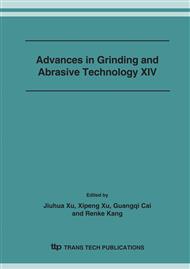p.360
p.365
p.369
p.374
p.379
p.384
p.389
p.394
p.399
Experimental Study on Lapping Force Characteristics of Hard-Brittle Materials in Ultrasonic Vibration Lapping
Abstract:
Hard-brittle materials have been popular used in manufacture experience because of their excellent performances. However the low plasticity, frangibility and non-conduction make the machining very difficult, especially in ultra-precise surface fabrication. Therefore, ultrasonic vibration is introduced to conventional lapping for the purpose of proper lapping force, higher removal rate and fine surface quality. Through conventional and ultrasonic lapping experiment of hard-brittle materials with different lapping parameters and different vibration models, the empirical formula of lapping force in ultrasonic lapping is deduced by orthogonal regression analysis, the optimum lapping parameters are put forward and the primary and secondary influencing sequence of parameters on lapping force is presented. Moreover, the influencing rule of different lapping parameters such as rotational speed, feed speed, oilstone grit and lapping depth etc. on lapping force is carried out. Experimental results show that ultrasonic vibration lapping is a high efficient processing method adapting to hard-brittle materials.
Info:
Periodical:
Pages:
379-383
Citation:
Online since:
November 2007
Authors:
Price:
Сopyright:
© 2008 Trans Tech Publications Ltd. All Rights Reserved
Share:
Citation:


